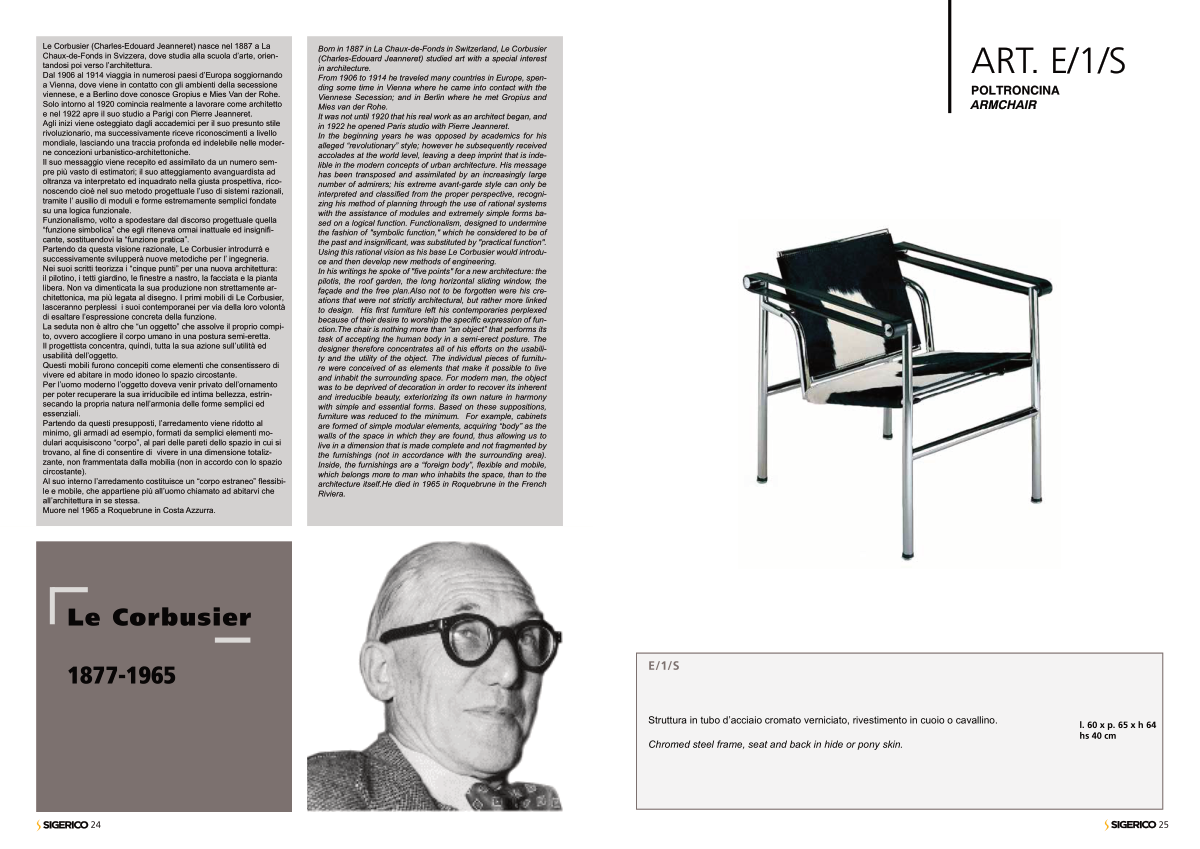Le Corbusier
1877-1965
Le Corbusier (Charles-Edouard Jeanneret) nasce nel 1887 a La
Chaux-de-Fonds in Svizzera, dove studia alla scuola d’arte, orien-
tandosi poi verso l’architettura.
Dal 1906 al 1914 viaggia in numerosi paesi d’Europa soggiornando
a Vienna, dove viene in contatto con gli ambienti della secessione
viennese, e a Berlino dove conosce Gropius e Mies Van der Rohe.
Solo intorno al 1920 comincia realmente a lavorare come architetto
e nel 1922 apre il suo studio a Parigi con Pierre Jeanneret.
Agli inizi viene osteggiato dagli accademici per il suo presunto stile
rivoluzionario, ma successivamente riceve riconoscimenti a livello
mondiale, lasciando una traccia profonda ed indelebile nelle moder-
ne concezioni urbanistico-architettoniche.
Il suo messaggio viene recepito ed assimilato da un numero sem-
pre più vasto di estimatori; il suo atteggiamento avanguardista ad
oltranza va interpretato ed inquadrato nella giusta prospettiva, rico-
noscendo cioè nel suo metodo progettuale l’uso di sistemi razionali,
tramite l’ ausilio di moduli e forme estremamente semplici fondate
su una logica funzionale.
Funzionalismo, volto a spodestare dal discorso progettuale quella
“funzione simbolica” che egli riteneva ormai inattuale ed insignifi-
cante, sostituendovi la “funzione pratica”.
Partendo da questa visione razionale, Le Corbusier introdurrà e
successivamente svilupperà nuove metodiche per l’ ingegneria.
Nei suoi scritti teorizza i “cinque punti” per una nuova architettura:
il pilotino, i tetti giardino, le finestre a nastro, la facciata e la pianta
libera. Non va dimenticata la sua produzione non strettamente ar-
chitettonica, ma più legata al disegno. I primi mobili di Le Corbusier,
lasceranno perplessi i suoi contemporanei per via della loro volontà
di esaltare l’espressione concreta della funzione.
La seduta non è altro che “un oggetto” che assolve il proprio compi-
to, ovvero accogliere il corpo umano in una postura semi-eretta.
Il progettista concentra, quindi, tutta la sua azione sull’utilità ed
usabilità dell’oggetto.
Questi mobili furono concepiti come elementi che consentissero di
vivere ed abitare in modo idoneo lo spazio circostante.
Per l’uomo moderno l’oggetto doveva venir privato dell’ornamento
per poter recuperare la sua irriducibile ed intima bellezza, estrin-
secando la propria natura nell’armonia delle forme semplici ed
essenziali.
Partendo da questi presupposti, l’arredamento viene ridotto al
minimo, gli armadi ad esempio, formati da semplici elementi mo-
dulari acquisiscono “corpo”, al pari delle pareti dello spazio in cui si
trovano, al fine di consentire di vivere in una dimensione totaliz-
zante, non frammentata dalla mobilia (non in accordo con lo spazio
circostante).
Al suo interno l’arredamento costituisce un “corpo estraneo” flessibi-
le e mobile, che appartiene più all’uomo chiamato ad abitarvi che
all’architettura in se stessa.
Muore nel 1965 a Roquebrune in Costa Azzurra.
Born in 1887 in La Chaux-de-Fonds in Switzerland, Le Corbusier
(Charles-Edouard Jeanneret) studied art with a special interest
in architecture.
From 1906 to 1914 he traveled many countries in Europe, spen-
ding some time in Vienna where he came into contact with the
Viennese Secession; and in Berlin where he met Gropius and
Mies van der Rohe.
It was not until 1920 that his real work as an architect began, and
in 1922 he opened Paris studio with Pierre Jeanneret.
In the beginning years he was opposed by academics for his
alleged “revolutionary” style; however he subsequently received
accolades at the world level, leaving a deep imprint that is inde-
lible in the modern concepts of urban architecture. His message
has been transposed and assimilated by an increasingly large
number of admirers; his extreme avant-garde style can only be
interpreted and classified from the proper perspective, recogni-
zing his method of planning through the use of rational systems
with the assistance of modules and extremely simple forms ba-
sed on a logical function. Functionalism, designed to undermine
the fashion of "symbolic function," which he considered to be of
the past and insignificant, was substituted by "practical function".
Using this rational vision as his base Le Corbusier would introdu-
ce and then develop new methods of engineering.
In his writings he spoke of "five points" for a new architecture: the
pilotis, the roof garden, the long horizontal sliding window, the
façade and the free plan.Also not to be forgotten were his cre-
ations that were not strictly architectural, but rather more linked
to design. His first furniture left his contemporaries perplexed
because of their desire to worship the specific expression of fun-
ction.The chair is nothing more than “an object” that performs its
task of accepting the human body in a semi-erect posture. The
designer therefore concentrates all of his efforts on the usabili-
ty and the utility of the object. The individual pieces of furnitu-
re were conceived of as elements that make it possible to live
and inhabit the surrounding space. For modern man, the object
was to be deprived of decoration in order to recover its inherent
and irreducible beauty, exteriorizing its own nature in harmony
with simple and essential forms. Based on these suppositions,
furniture was reduced to the minimum. For example, cabinets
are formed of simple modular elements, acquiring “body” as the
walls of the space in which they are found, thus allowing us to
live in a dimension that is made complete and not fragmented by
the furnishings (not in accordance with the surrounding area).
Inside, the furnishings are a “foreign body”, flexible and mobile,
which belongs more to man who inhabits the space, than to the
architecture itself.He died in 1965 in Roquebrune in the French
Riviera.
25
ART. E/1/S
Struttura in tubo d’acciaio cromato verniciato, rivestimento in cuoio o cavallino.
Chromed steel frame, seat and back in hide or pony skin.
POLTRONCINA
ARMCHAIR
l. 60 x p. 65 x h 64
hs 40 cm
24
E/1/S


